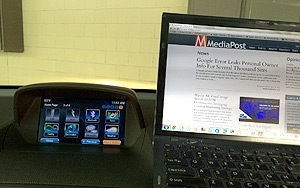GM Listens Globally, Reworks Products Responding To U.S. Twitter, Facebook Posts
- by Laurie Sullivan @lauriesullivan, March 20, 2015
 General Motors is launching an enterprise wide social tool to its international operations, adding to its North America, South America, and European presence.
General Motors is launching an enterprise wide social tool to its international operations, adding to its North America, South America, and European presence.
Sharing content brings consistency to global campaigns and listening to customers on social media allows the automaker to make product changes more quickly.
GM laid the foundation last year, with plans to have it roll out in 2015.
GM sell many Buicks in China, said Rebecca Harris, senior manager of global social media strategy for the automaker. The brand gains access to Facebook and Twitter through its platform, but a partnership with Oracle and support through its Social Cloud now provides access to consumers in China through the social site Weibo, many of whom prefer mobile.
Oracle announced a partnership with Weibo at South By Southwest (SXSW).
advertisement
advertisement
Weibo's mobile focus continues to grow. Some 54% of Q4 ad revenue was from mobile vs. 44% in Q3 and 39% in Q2, per Piper Jaffray. Mobile revenue grew more than 200% year over year and 65% sequentially.
On mobile and desktop, GM marketers simply adjust the copy to the audience and push it out to local consumers. The Oracle Social Cloud monitors and reports on when and where consumers interact.
Those consumers sounding off in social networks have become the impetus for changes in GM's products. Last year, around the North America auto show, GM launched the full-size Silverado and GMC Sierra. Shortly after, GM heard from consumers on social media that the steering wheels were hot in the southern states and the cool heated seats on the driver's side blew hot air into the back seat area.
Social data lets big companies make changes much more quickly because they have the data to backup the problem. GM has aligned its business units to work more closely together. Seeing the same complaint five times on social media elevates any issues to GM's quality team, which takes it directly to the company's manufacturing and engineering teams.
For this instance, the automaker took the steering wheel out of production within 30 days and rerouted the vents to fix the heated-seat problem on the assembly line, explains Harris.
Fixing a problem like the steering wheel and vent in the past would have begun with the consumer walking into the dealership, the dealership putting in a checklist with the service guy, the service guy taking the problem back to the quality guy. Then the debate would start on whether it really needs fixing. Six months later, consumers might see a change.
"Sometimes. it takes a little longer to fix, because they're no easy solution," Harris admits. "Sometimes, listening to consumers on social media helps add new features not previously in cars or trucks."
One of those changes meant adding OnStar 4G LTE in nearly every model truck and car from GM built in 2015. The service connects up to 10 devices. It works in conjunction with the consumer's cellular data plan through AT&T, but will expand into some of the other providers.


